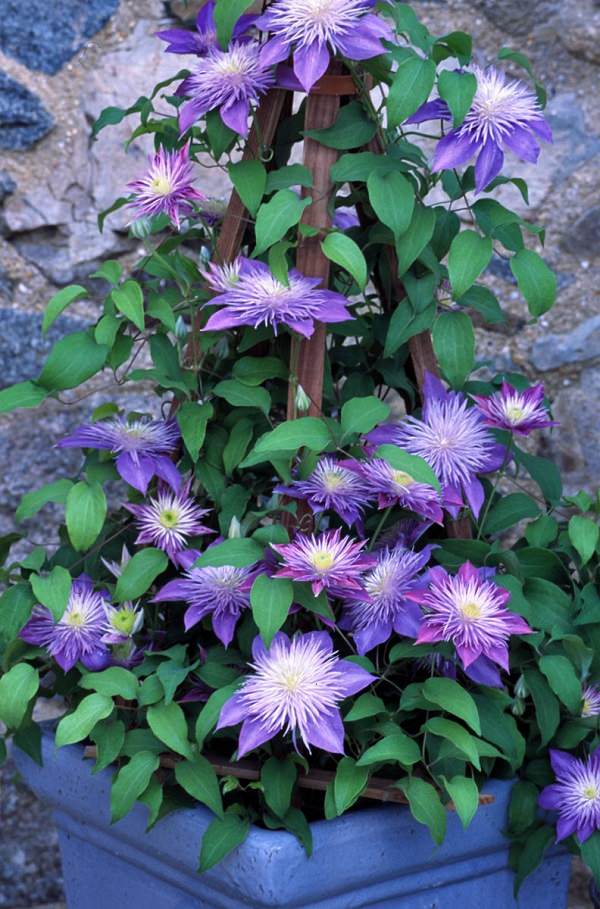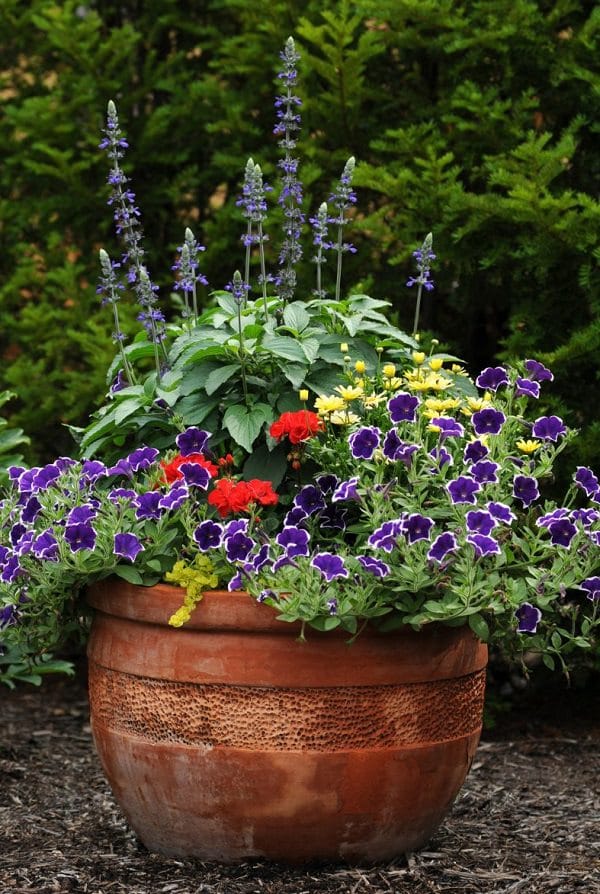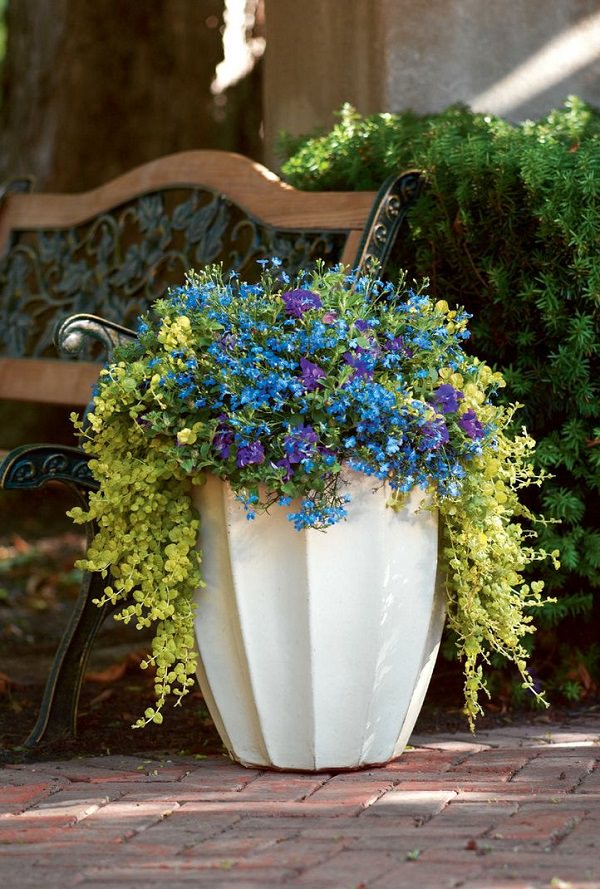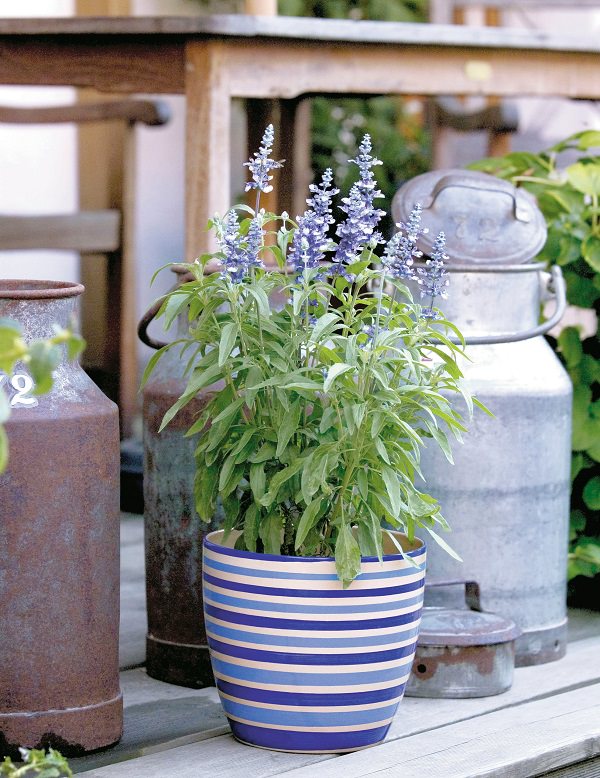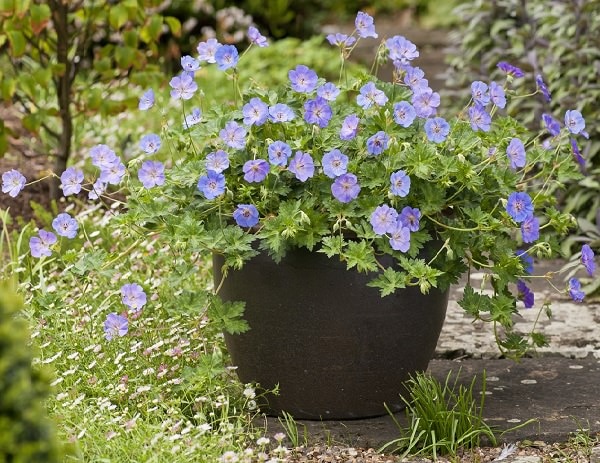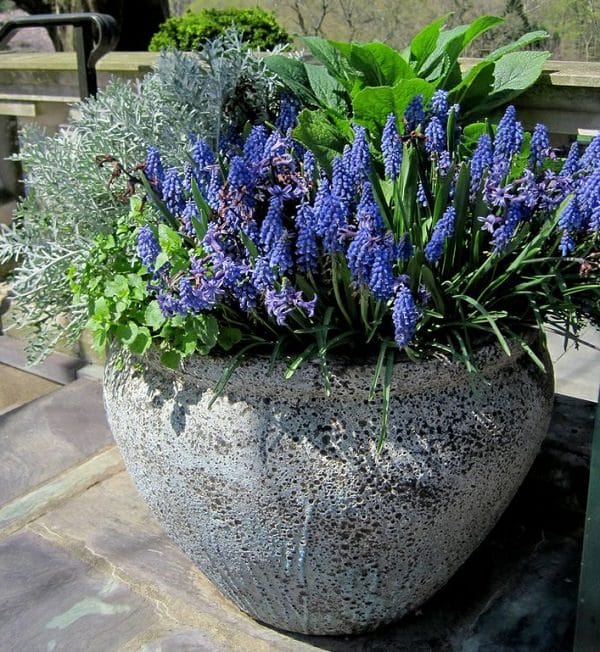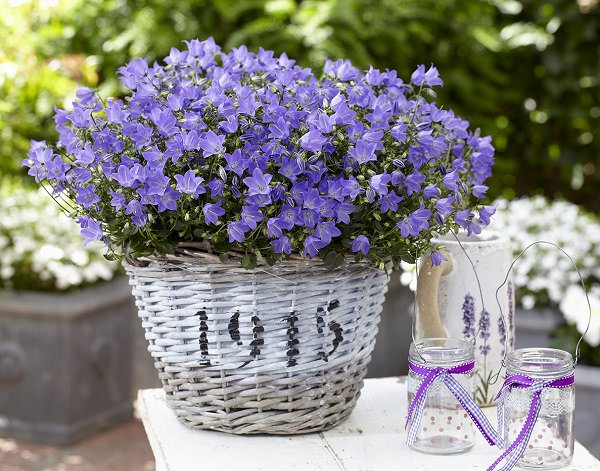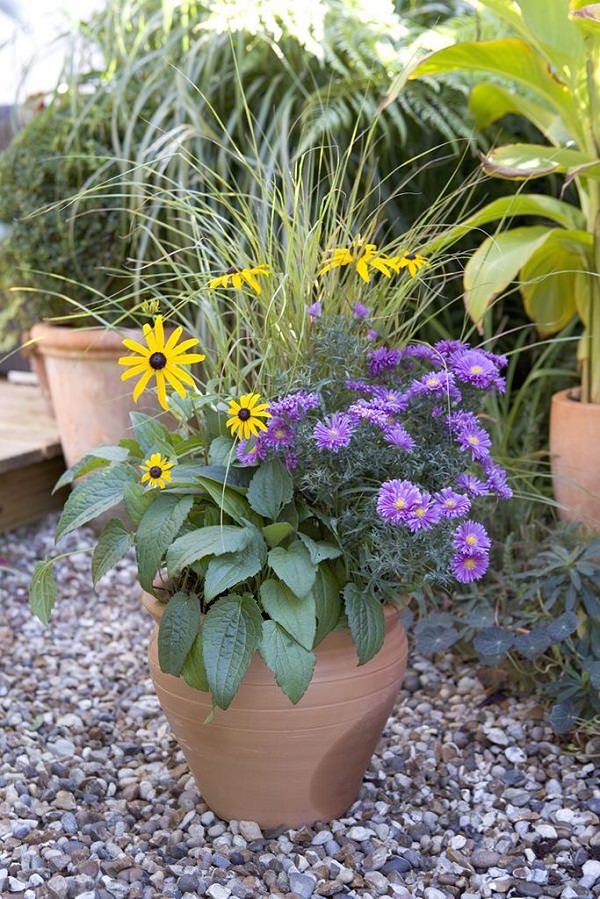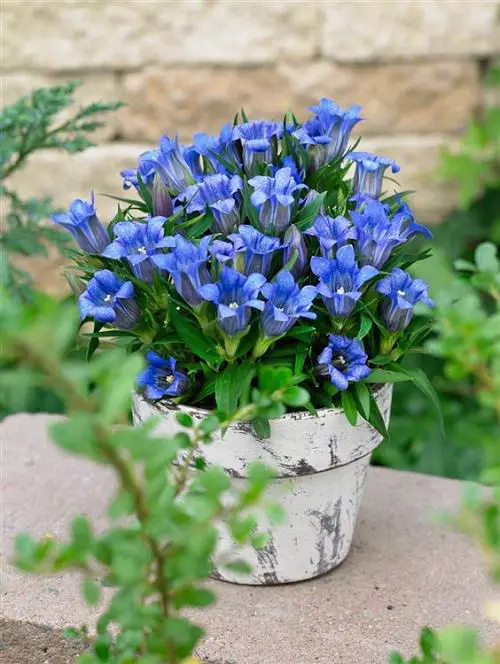If you love the color ‘BLUE‘ and want the same blossoms, then you’re at the right place! Here are the Best Blue Flowers To Grow In Containers!
Blue is the color of calmness and serenity. Having blue color blossoms in your garden will add positive vibes while bringing a lot of appeal to the landscape! Here is an exclusive list of some of the Best Blue Flowers To Grow In Containers to help you pick the one you like the most!
Best Blue Flowers To Grow In Containers
1. Morning Glory ‘Heavenly Blue’
Botanical Name: Ipomoea tricolor
USDA Zones: 9-11
Climate: Morning glory is a frost-tender vine that is perennial in warm climates
Only very few flowers provide true blue color like the ‘Heavenly Blue’ Morning Glory. Growing morning glory in containers is absolutely easy in a medium-sized pot. Keep the plant in full sun, provide some shade in the afternoon (if the sun is intense in your area), and it will grow.
2. Hydrangea
Botanical Name: Hydrangea macrophylla
USDA Zones: 3-9
Climate: Hydrangeas can be grown in temperate and moderately warm climates.
Hydrangeas can change the color of their blooms according to the soil pH. If the soil is acidic, they turn blue (add soil sulfur to lower the pH). For growing hydrangeas in pots, a large container is required with a diameter of at least 18 inches. Provide morning sun with shade in the afternoon and moist and well-drained soil.
Also Read: Best Shrubs for Containers
3. Clematis
Botanical Name: Clematis x jackmanii
USDA Zones: 3-9
Climate: You can grow clematis in a variety of climates; varieties are available for warmer (USDA Zones– 10 – 11) regions too.
Growing clematis is possible in a large container. There are many blue clematis cultivars available– Ice Blue, Blue Pirouette, Emilia Plater, Blekitny Aniol, Arabella, Dominika, Petit Faucon, Durandii, Fryderyk Chopin, etc. Keep your potted clematis in a spot that receives full sun, water well, and provide support.
4. Cornflower (Bachelor’s Button)
Botanical Name: Centaurea cyanus
USDA Zones: 2-11
Climate: As cornflower is grown as an annual, it can thrive easily in almost all the climates
This wildflower can be an excellent addition to your container garden if you like to have a cottage garden-like feeling and attract wildlife. As it never grows above 3 feet tall, a small to a medium-sized container is what you need. This low-maintenance flowering plant blooms a lot with regular deadheading. To learn about its varieties, click here!
5. Rose of Sharon
Botanical Name: Hibiscus syriacus
USDA Zones: 5-9
Climate: Prefers moderate climate but can be grown in hot areas with care
One of the most popular ornamental shrubs, you can grow this hardy hibiscus in a container. A few of the best blue varieties (don’t expect true blue) you can look for are Blue Bird, Blue Chiffon, and Blue Satin. The shrub has the potential to grow up to 8-10 feet tall on the ground. So you may need a medium to large size container.
Note: Choose the size of the container according to the current state of the plant.
6. Delphinium
Botanical Name: Delphinium
USDA Zones: 3-8
Climate: Growing this flowering plant is possible if you live in a climate with cool summers
Delphiniums are great for spicing up the borders in summer, but this doesn’t mean that you can’t grow them in containers. The true blue color they offer is rare. Choose a medium to small size container (depending on the type you’re growing).
7. Viola/Pansy
Botanical Name: Viola tricolor var. hortensis
USDA Zones: 2-11
Climate: Can be grown as an annual/biennial in almost every climate
The names “Viola” and “Pansy a.but there is a slight difference in them. While they bloom in fall and spring, the blooming period of these beautiful flowers is winter in hot areas (USDA Zones 10-11). They come in almost every color, and you can easily find a variety in the shade of blue. True Blue, Blue Blotch, and Neon Violet are a few names you can look for.
8. Petunia
Botanical Name: Petunia x hybrida
USDA Zones: 9b-11
Climates: Growing petunia is possible in every climate as an annual. They are perennial in warm climates
The most favorite annual flower, available in almost every color and blooms so abundantly. Petunia flowers are absolutely joyful to look at. You can easily find transplants in blue color in your nearby nurseries or look at seed catalogs on the web for more options. Read these petunia growing tips to learn growing petunias in pots!
9. Lobelia
Botanical Name: Lobelia erinus
USDA Zones: All Zones
Climate: Lobelia can be grown in any climate as an annual
Lobelia is another annual that we loved to add to our list of best blue flowers for containers. While many of its varieties are available in white, pink, and red, the most commonly seen color is blue. You can grow it in small containers, spilled flower pots, and hanging baskets, and in beautiful container arrangements as a filler like this arrangement above– Lobelia, creeping jenny, and purple petunias!
10. Pincushion Flower
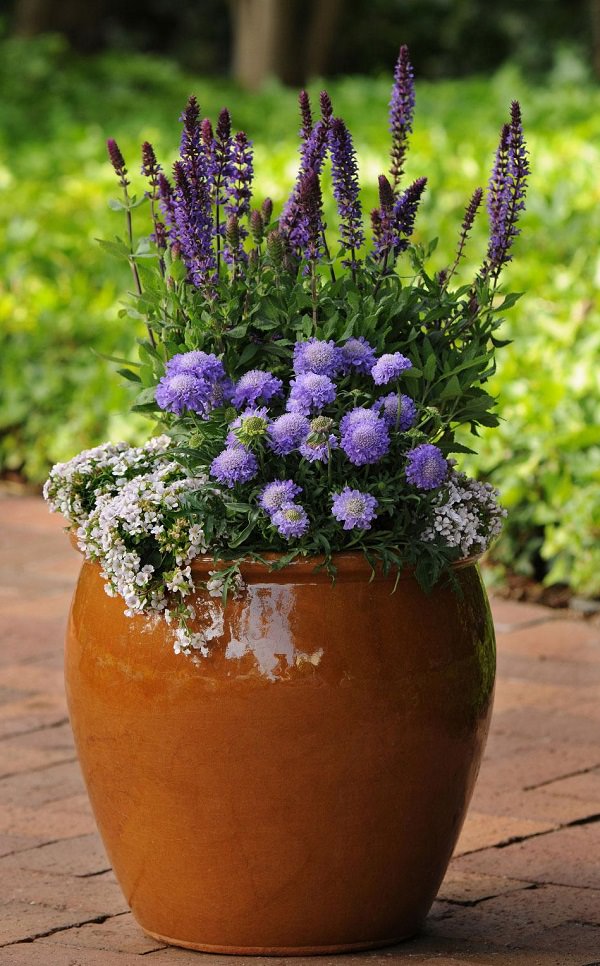
Botanical Name: Scabiosa
USDA Zones: 3-11
Climate: It is possible to grow it in almost every climate, either as a short-lived perennial or an annual.
Growing scabiosa in containers is not difficult. Providing it the full sun is a good idea. However, if you live in a warm climate, it is better to keep this plant in the partial sun. They are low maintenance and have a very long flowering season.
11. Salvia
Botanical Name: Salvia splendens
USDA Zones: 9-11
Climate: Most salvias prefer warm subtropical and tropical climates to grow as a perennial, but they are a cinch to grow even in cold areas as an annual.
Choose a medium-sized container that is wide and place it in a spot that receives full sun (shade in the afternoon in the tropics). Keep the soil moist but see if it remains well-drained. See this article to learn about the best blue salvia varieties.
12. Geranium
Botanical Name: Geranium dissectum
USDA Zones: 4-9
Climate: Hardy geraniums are cold tolerant and thrive best in moderately cool climate
Hardy geranium (cranesbill) has really long growing season in the garden. They are low maintenance and suitable for container planting. There are varieties like Geranium ‘Rozanne’ and Geranium Johnson’s Blue that provide alluring blue color. You can even grow them in hanging baskets and window boxes. To learn about growing geranium in containers, click here!
13. Grape Hyacinth
Botanical Name: Muscari
USDA Zones: 4-8
Climate: Suitable for most climates except tropical and semi-arid regions
This spring-flowering bulb provides a beautiful blue color and looks like a miniature hyacinth. Easy to grow in containers, it doesn’t grow above 8 inches tall. You can combine several of them with other annuals or grasses. Keep it in full sun or partial shade and water moderately. Avoid waterlogging of soil by checking if it’s well-drained and avoid overwatering.
14. Plumbago
Botanical Name: Plumbago auriculata
USDA Zones: 8-11
Climate: It is perennial in a tropical and subtropical climate, but you can try to grow it in temperates (down to Zone 5) by keeping it indoors in winter.
Growing plumbago in containers is not at all difficult if you take care of its basic needs, provide full sun and water moderately when required. It can be trained as a shrub using a stake and looks so fascinating when in bloom. The sky-blue colored flowers make this plant worth trying.
15. Dwarf Morning Glory

Botanical Name: Evolvulus
USDA Zones: 9-11
Climate: It loves warm weather, heat, and full-day exposure to the sun
This morning glory cousin is also called known as dwarf morning glory. It can be grown in containers, hanging baskets, and designer planters. Its sky blue flowers are true blue, a hybrid called ‘Blue My Mind’ has more intense flowers, which is available at Proven Winners!
16. Bellflower
Botanical Name: Campanula
USDA Zones: 3-11
Climate: The flowers of this genus can be grown in any climate (depending on the type), either as a perennial, biennial or annual.
Bellflowers are available in pink, violet, white, and blue colors. You can grow them in small to medium-sized containers and hanging baskets.
17. Aster
Botanical Name: Aster amellus
USDA Zones: 3-9
Climate: Aster prefers a climate with cool summers. In hot climates, it can be grown as an annual.
This prolific flower blooms in summer and fall and is available in so many colors, including blue. While some of its varieties can grow up to 6-8 tall, it is usually a low-growing flowering plant.
18. Balloon Flower
Botanical Name: Platycodon grandiflorus
USDA Zones: 3-9
Climate: Suitable for cold climates
Balloon flower is known for its balloon-shaped unopened flower buds. However, the open flower is more star-shaped and available in the shades of pink, white, and blue. Growing it is easy in pots. Keep the plant in a spot that receives full sun but shade in the afternoon in warmer regions.
19. Iris
Botanical Name: Iris germanica
USDA Zones: 3-10
Climate: Irises prefer a cool and moderate climate, but the varieties are also available for hot regions. Visit Florida Gardener to learn more
While blue and purple are the most common colors in bearded varieties, you can look for other colors when growing iris in containers. A 12 inches pot is sufficient for a bearded iris. Choose a sunny spot and water frequently, but only when the soil dries out.
20. Summer Snapdragon
Botanical Name: Angelonia
USDA Zones: 9-11
Climate: Perennial in warm climates, grown as an annual in colder regions
Angelonia is one of the best performers in the harsh summer heat, available in colors like pink, white, red, purple, and especially blue. It is easy to grow in a pot and has a long blooming period.
21. Virginia Bluebells
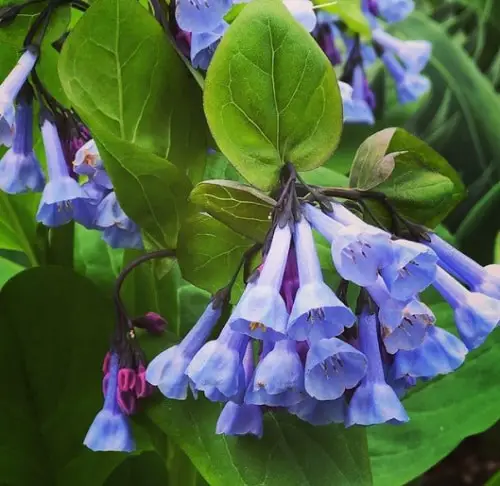
Botanical Name: Mertensia virginia
USDA Zone: 3-8
Climate: You can grow them in moderately warm climates.
With stunning clusters of baby blue flowers, Virginia Bluebells is loved by both bees and butterflies. Grow it in pots with drainage holes filled with rich, organic material under the dappled sun or partial shade.
22. Blue Daisy
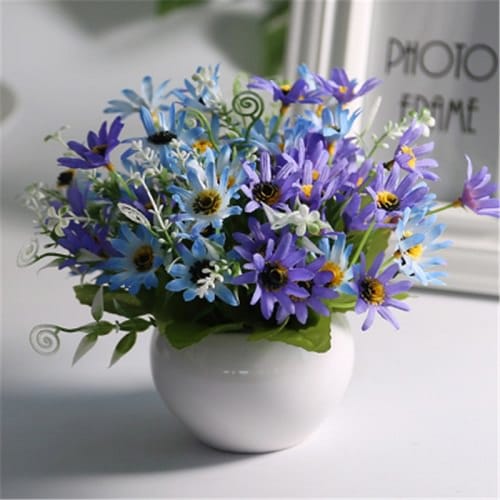
Botanical Name: Felicia amelloides
USDA Zone: 10-11
Climate: It does well as a perennial in warm climates.
Blue daisies showcase beautiful sky blue flowers with a yellow center. It can be grown from both seeds and cuttings. Grow ‘Blue daisy’ in well-drained soil under full sun. For best visual delight, plant them with different bright color flowers.
23. Lily of the Nile
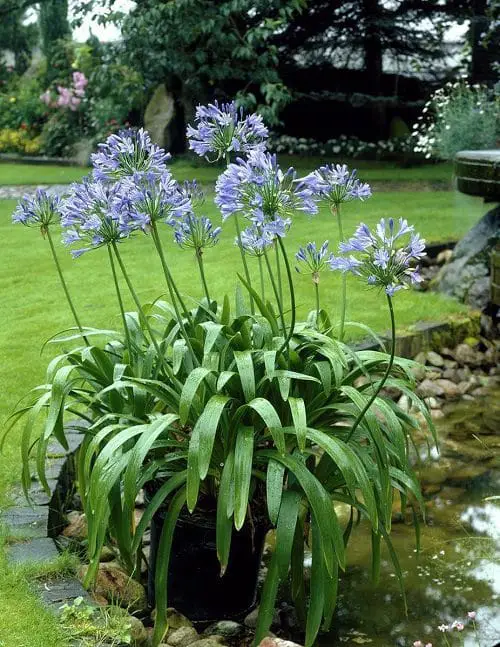
Botanical Name: Agapanthus umbellatus
USDA Zone: 8-11
Climate: It does best in hot to warm climates.
Brighten up your garden or indoor space with spherical clusters of funnel-shaped blue flowers. It grows well in medium-sized containers in moist, fertile, and well-draining soil in full sun to partial shade. This plant is drought tolerant and needs moderate watering.
24. Swan River Daisy
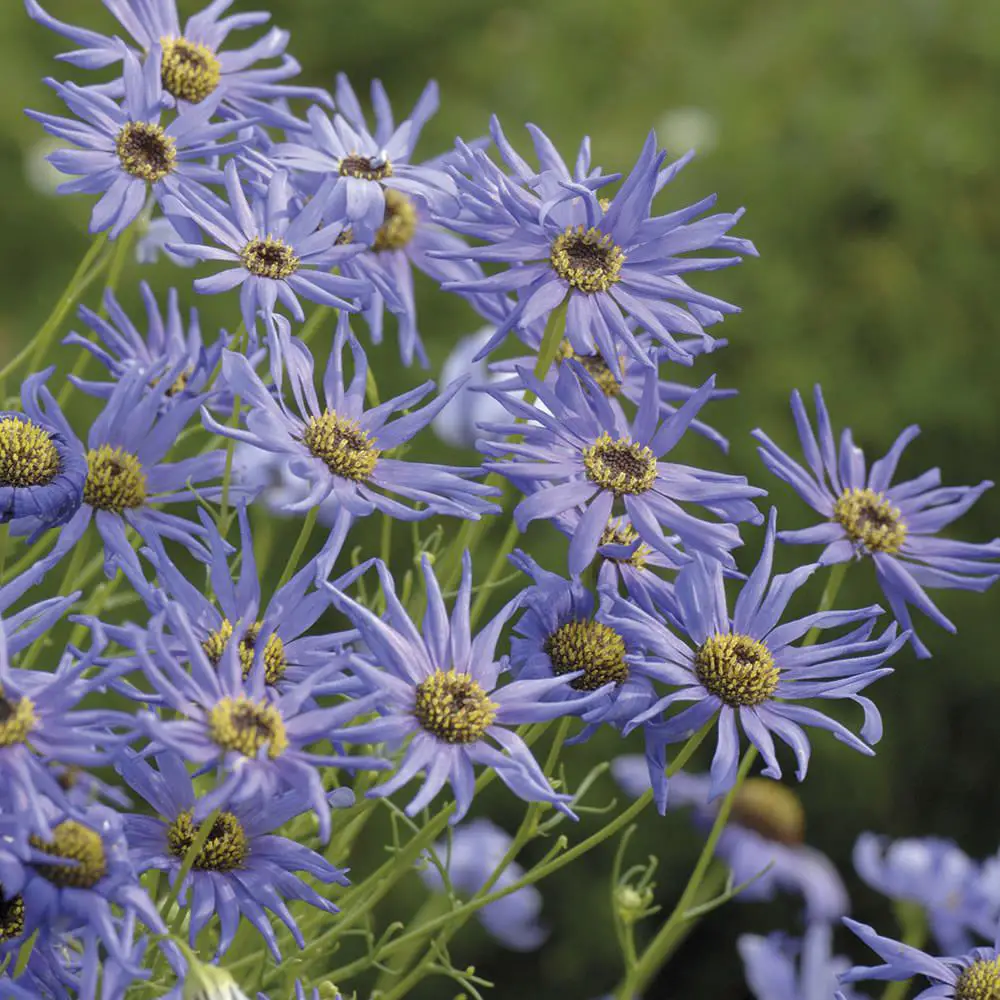
Botanical Name: Brachyscome iberidifolia
USDA Zone: 8-10
Climate: Cool summer climates are the best to grow this plant.
This Australian daisy can be used as a fun pop color in your container. It can handle a variety of soil and is an excellent heat and disease-resistant plant. Avoid overwatering, and it will continue to amaze you with its stunning blossoms!
25. Forget-me-Not
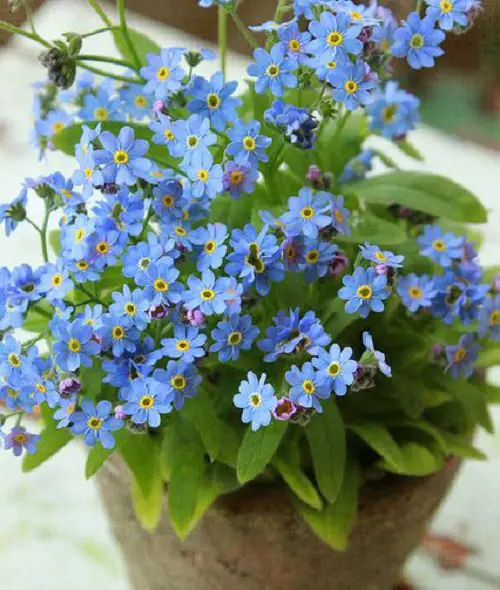
Botanical Name: Myosotis palustris ‘Southern Blues’
USDA Zone: 5-9
Climate: This annual flower prefers a cool climate.
The glossy, bright green leaves and small blue flowers with a yellow eye look perfect in pots. They look extremely well when planted in large numbers and are great for rock gardens or edging plants.
26. Blue Phlox
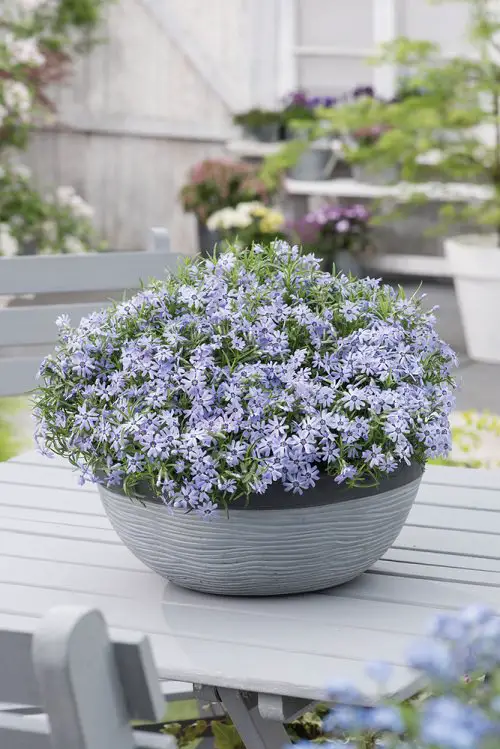
Botanical Name: Phlox divaricata
USDA Zone: 3-8
Climate: This semi-evergreen perennial does well in mild climates.
Native to eastern North America, Blue phlox features fragrant lavender-blue or powder blue flowers in spring. It also grows well in containers under partial shade in humusy, moist, well-draining soil.
27. Sea Holly
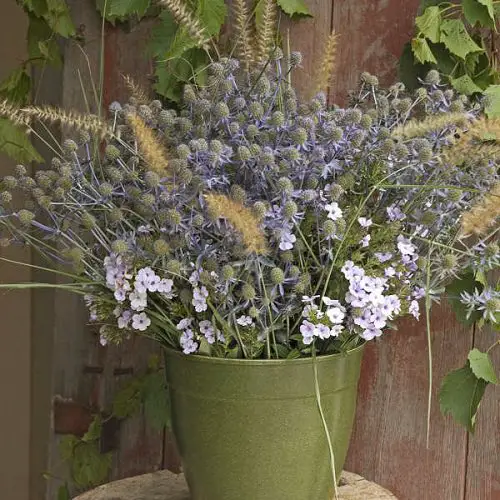
Botanical Name: Eryngium maritimum
USDA Zone: 4-9
Climate: This ornamental perennial does well in mild cold and warm climates.
Sea Holly is an ideal choice if you want blue flowers during summer. Prickly blue bracts surround the unique oval-shaped steel-blue flower heads. It can grow up to 6-18 inches tall in sandy soil under full sun.
28. Blue Fan Flower
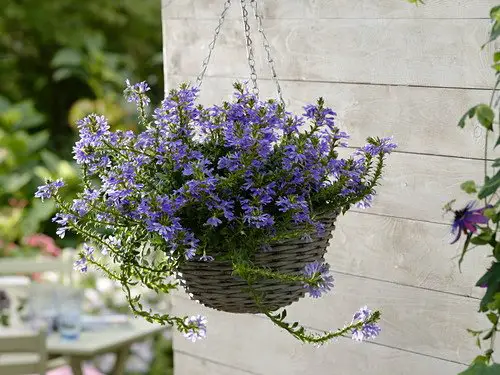
Botanical Name: Scaevola aemula
USDA Zone: 10-11
Climate: They are perennials in the US and do well in warm to hot climates.
Also known as ‘fairy fan-flower,’ it is distinguished by its heat and drought tolerant blue fan-shaped flowers. You can grow it in containers or hanging baskets in well-draining soil under full sun to partial shade. Keep in mind that the plant doesn’t like overwatering.
29. Beth’s Blue
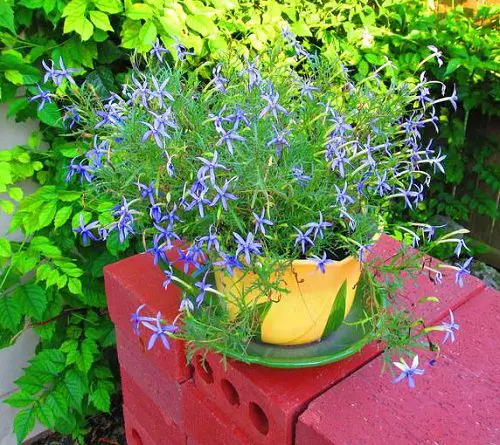
Botanical Name: Isotoma axillaris
USDA Zone: 8-10
Climate: As a perennial, it does well in warm climates.
Beth’s Blue forms a profusion of star-shaped blue flowers with a yellow center on a cushion of mid-green foliage. It is often grown as filler–while growing in containers, use well-drained soil and place the pots in full sun to partial shade.
30. Himalayan Blue Poppy

Botanical Name: Meconopsis betonicifolia
USDA Zone: 7-8
Climate: A Perennial, the plant does well in cool, damp summers.
Also popularly known as the Queen of Himalayan flowers, the Himalayan Blue Poppy shines with large cool blue flowers and hairy leaves. The stunning array of yellow centers pairs gorgeously with the outer petals.
31. Columbine
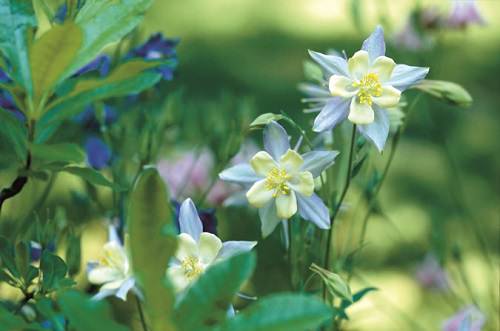
Botanical Name: Aquilegia alpina
USDA Zone: 3-9
Climate: Easy-to-grow perennial, it does well in the mild cold to warm climates.
The beautiful bell-shaped blue-white flower with yellow stamen floating on dark green foliage that turns maroon in fall looks adorable in containers. It prefers full sun in the north but doesn’t like too hot summer.
32. Flax Flower
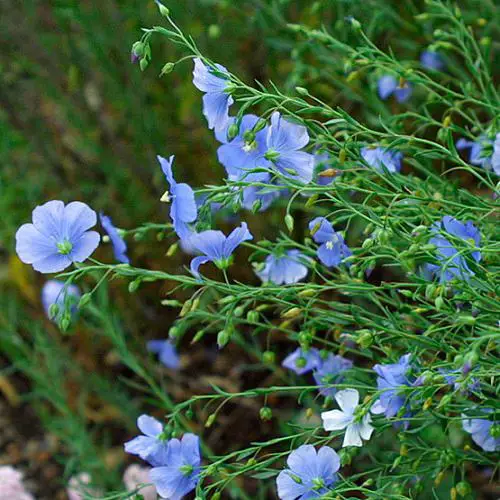
Botanical Name: Linum lewisii
USDA Zone: 4a-9b
Climate: A perennial flower, which does well in cold to moderately warm climates.
Native to California, the five-petaled blue flower starts to bloom in May till September. The plant is also the source of the famed flax seeds that are a rich source of Lignans and have various uses.
33. Japanese Gentian
Botanical Name: Gentiana scabra
USDA Zone: 3-9
Climate: Perennial or annual, it does well in both mildly cold to warm climates.
If you want ‘True’ blue flowers, then gentian is a perfect choice for you. The plant displays deep blue upturned trumpet-shaped flowers with mat-like foliage from May to September. It’s a great plant to grow in both containers and gardens.
34. Monkshood

Botanical Name: Aconitum
USDA Zone: 3-7
Climate: A perennial, it does well in regions with mild summer.
If you are fond of blue flowers, monkshood can be a good option for your plant collection. It can grow up to 2-4 feet tall with palmate light to dark green leaves with striking spires of purple-blue flowers that bloom from late summer to early fall.
Note: All parts of the plant are toxic; hence keep it out of reach of children or pets. Always wear gloves while handling the monkshood plant.
35. Brunnera

Botanical Name: Brunnera macrophylla
USDA Zone: 3-7
Climate: A rhizomatous perennial, it does well in moderately cold to warm climates.
Brunnera, with its pale blue flowers and heart-shaped leaves, can be a focal point in your garden or home. You can grow ‘Jack Frost,’ a popular variety with silver splashed foliage and blue flowers.
36. Lead Plant

Botanical Name: Ceratostigma plubaginoides
USDA Zone: 5-9
Climate: A herbaceous perennial, it does well in warm climates.
Also popular by the names Downy indigo bush and buffalo bellows, Lead Plant looks beautiful with tiny purple to blue flowers that grow in masses over a stalk. The blossoms contrast nicely with the silver-gray foliage of the plant!




